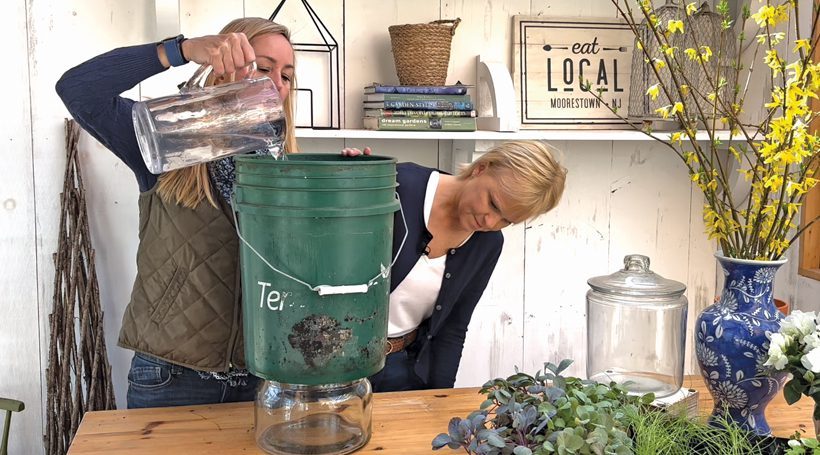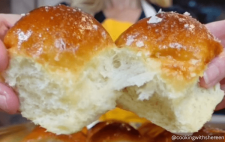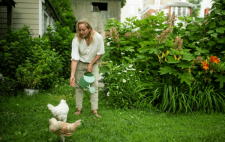We’re halfway through season 5 of “The Goal is to Become a Gardener,” and this year we’ve been talking sustainability. Here are some tips you might have missed, and be sure to watch our first 3 episodes on SJ Mag’s Facebook page.
Making worm tea takes a while.
Who knew filtering water through a bucket of dirt, food and worms to make worm tea was such a time-consuming task?
And if you’re asking yourself, what is worm tea? Buckle up.
It turns out, worm poop is one of the best things for your garden. And a worm farm is a way to harness that and boost your soil health, helping your food and flowers grow beautiful and healthy.
If you tuned in to last season of The Goal is to Become a Gardener, you watched (and laughed) along as Marianne and Toni made a worm farm with a bucket, dirt, some biostimulant and lots of worms.
And this year, it was time to make worm tea. Once you’ve had your worm farm working for a while, you can pour water on it and let it drain out of the bottom of the bucket – which you’ve drilled holes into – to make worm tea. Then, pour that water in your garden, because it’s an excellent fertilizer for your plants.
But be prepared, that water usually takes about 1 to 2 hours to fully drain through your lovely worm farm. You’ll be able to leave it to drain, but this isn’t an “instant” situation.
And it’s totally worth it.
Compost isn’t fertilizer.
Speaking of fertilizer, we learned a lot of methods to help boost our soil health this year as we kicked off The Goal is to Become a Gardener’s sustainability season. Including the fact that you need both fertilizer and compost to help your garden grow beautiful and healthy.
Compost and fertilizer may seem very similar. They both support our gardens in similar ways, but they’re actually doing slightly different things that are each crucial to your progress.
Fertilizer can be synthetic or organic, and when you add it to your garden, you’re adding NPK (nitrogen, phosphorus and potassium) and micronutrients back into the soil, which our plants need to grow.
Compost is only organic matter. It’s everything that’s broken down in your backyard plus leaves, twigs, dead animals and some animal manure mixed together. Compost adds a bit of nutrients to the garden, but also adds massively to the soil structure, soil health and the microbiome that’s so important for plant health.
Bees are the bees’ knees.
“Save the bees” is a great cause for gardeners. Bees play a huge role in our gardens as pollinators. In fact, about 35% of the world’s food crops depend on animal pollinators like bees to reproduce. The pollinators, while searching for food, will brush against plants and cause pollen to fall from the anther to the stigma, beginning fertilization.
But “save the bees” is a bit too broad of a phrase to accurately describe what we have to do to help our busy pollinators. While a huge portion of honey bees in the U.S. are dying off each year, some native bees are endangered.
That’s because honey bee populations can be pretty easily regenerated – the U.S. has added nearly 1 million bee colonies in the past 5 years – by splitting and restocking hives or by finding or buying new queens. So while the U.S. honey bee population experienced a 48% death rate between 2022 and 2023, it was managed by these repopulation practices.
Natural bees, however, are not receiving such treatment. Of 4,000 native bee species in the U.S., many don’t have colonies, they don’t have queens. They often live on their own and some nest in the ground. So when they die off for the same reasons the honey bees’ populations do, it’s not as easy to repopulate.
And if you’re saying, “Well that’s fine, because we have the honey bees!” unfortunately, that’s not how it works. There are some crops – like tomatoes, eggplants and peppers – that can’t be pollinated by honey bees.
But there are measures we can take to help save these native bees. A big one is growing pollinator gardens in our yards. Since habitat loss is a large cause of the decline in bee populations, building bee gardens where they will have a safe area with plenty of food can help. As part of that, you’ll want to use organic gardening practices to keep harmful chemicals away from the insects.
You can be a DIY queen (or king)
We’ve tried our fair share of DIY projects on The Goal is to Become a Gardener, from pole lights to fountain features. But the DIY possibilities don’t stop at aesthetic additions to our gardens. They can also be used to protect our plants.
This year, Marianne and Toni show us how to create our own fruit cages – structures that will keep bunnies and squirrels from nibbling on our delicious foods. And it only takes a few steps and two materials: chicken wire and zip ties.
You can watch a demonstration in the latest episode of The Goal is to Become a Gardener.
Marianne still doesn’t like dirt.
Are we surprised though?
Yes, the gloves have come off – and we call that growth – but that doesn’t mean she has to be happy about it, or keep quiet about that. But, hey, maybe one of these days she’ll love dirt as much as Toni does. There’s only one way to find out.
See you later this summer for the rest of this season of The Goal is to Become a Gardener.

Watch Season 5! New episodes are on SJ Mag Media’s Facebook page now!




















